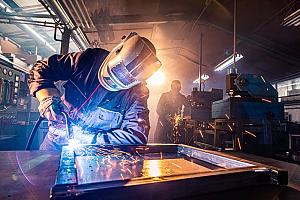Editor-in-Chief
- FMA
- The Fabricator
- FABTECH
- Canadian Metalworking
Categories
- Additive Manufacturing
- Aluminum Welding
- Arc Welding
- Assembly and Joining
- Automation and Robotics
- Bending and Forming
- Consumables
- Cutting and Weld Prep
- Electric Vehicles
- En Español
- Finishing
- Hydroforming
- Laser Cutting
- Laser Welding
- Machining
- Manufacturing Software
- Materials Handling
- Metals/Materials
- Oxyfuel Cutting
- Plasma Cutting
- Power Tools
- Punching and Other Holemaking
- Roll Forming
- Safety
- Sawing
- Shearing
- Shop Management
- Testing and Measuring
- Tube and Pipe Fabrication
- Tube and Pipe Production
- Waterjet Cutting
Industry Directory
Webcasts
Podcasts
FAB 40
Advertise
Subscribe
Account Login
Search
The cutting edge of leveling knife blanks
Automated leveling equipment helps Winkler Knives stay on top of its production commitments
- By Dan Davis
- June 20, 2024
- Article
- Metals/Materials

This Drop Point Crusher Knife from Winkler Knives has been cut, leveled, stress-relieved, ground, and heat-treated in a way that makes it a favorite of those in the Special Operations Forces community.
Sometimes you can best serve your country by serving those in the armed forces.
Daniel Winkler got that opportunity in the years after Sept. 11, 2001. Of course, the world changed dramatically on that fateful day, and Winkler soon changed with it.
Before 2001, Winkler was primarily a full-time knifemaker, having achieved master bladesmith accreditation from the American Bladesmith Society in 1993. He and Karen Shook, his sheath-making partner and wife, had built a successful business, and their products had gained a widespread following, including that of a member of the U.S. Navy’s SEAL (sea, air, and land) team. He wanted a better breaching/combat axe than his employer was offering and approached Winkler about developing such a tool. That’s how Winkler’s first axe designed for the special forces community—a full-tang axe with a combat spike—was born.
When the World Trade Center towers came down, the SEAL, who was then retired, entered active service again as part of U.S. Army Special Operations Forces—and he brought along his favorite axe. As others saw the custom-made axe in action, they wanted one as well. The increased demand led Winkler to rethink how he could transition his manual processes to more automated approaches while still maintaining the quality of the knives and axes that people expected. Believing that the right material, machine tools, and processes could deliver the same high-quality products, Winkler changed the direction of his company. Winkler Knives was open for business.
“To assure high and unfailing performance, you need to do things right. These [Special Operations Forces] literally put their lives on the line when they are using this equipment, so we aren’t going to shortcut anything,” Winkler said.
Setting Up Shop
When Winkler Knives ramped up production efforts, it tried to find machine tools that closely replicated the manual techniques used for the custom-made pieces. The strategy was sound, but some of the machine tool choices didn’t initially work out.
For instance, instead of sawing out an axe handle individually, operators would take wooden pieces of the same thickness, stack them, and cut them with a band saw, maximizing the production effort. However, Winkler deemed that as too great an injury risk for employees. Today, laser cutting technology is used to cut out the handles, with no compromise in the handle performance or quality.
A band saw, this time designed for metal, was used to cut the blade blanks as well. That was ditched when Winkler learned about waterjet cutting, which allowed for much higher-tolerance cuts but didn’t change the metal makeup in any way.
“Then we learned that by paying someone else for this waterjet cutting service, we were buying somebody else a waterjet,” Winkler said. “So we just bought our own.”
When it came to grinding down the waterjet-cut blanks, Winkler Knives initially invested in some early CNC grinding machines, which relied on old-school PCs and floppy disks to work. Those devices were able to remove up to about 70% of the material on the blade before the skilled hands of a manual grinder took over. When Winkler was unable to find someone to repair one of the machines, he looked for something more modern. The new machines are able to remove about 90% of the material before final hand finishing takes place.

A machine operator places some waterjet-cut blades on the leveling machine. The leveling action flattens the blades and removes internal stresses from the metal.
After the blades are ground, they are heat-treated individually in a salt pot system. In the metals world, most people think of heat treating being done in large industrial ovens. The issue with that approach is that when the steel hits a critical temperature, the carbon molecules start moving around within the steel matrix, with some even escaping to the surface. (Think about how a blacksmith works and how scale appears on the anvil during the metal forming process. That scale is carbon migrating out of the steel.) Carbon loss is not good for blade performance, according to Winkler.
Molten salts formulated to melt at different temperatures create an oxygen-free atmosphere for treating blades. If a 0.87% carbon blade is put into the salt pot, heated up, taken out, and quenched, it’ll still be a 0.87% carbon blade.
“There are professional heat treaters that will also use salt pots if you request them, but most of them use ovens where they try to remove the oxygen from the atmosphere to minimize carbon loss. That’s all fine, but a liquid heat sink is more efficient in getting blades to a homogenous temperature before the quench,” Winkler said.
Providing Stress Relief to the Metal
Heat-treating the blades in the salt pot system provided a hardened blade that was likely to stand up to whatever users could throw at it. But in some circumstances, after heat treating and quenching, warpage would occur in the metal blades. At that point, the manufacturing team couldn’t do much to save a blade because it was hardened at that stage.
The warpage was caused by stresses introduced to the material during steelmaking. As the material is cooled, stresses in the microstructure are generated. Also, during coiling, the material undergoes significant elongation as it is looped over itself.
To eliminate this stress, Winkler purchased an ARKU EcoMaster 30-30 precision leveling machine. With a maximum part width capability of 12 in., the machine handles thicknesses from about 0.012 to 0.20 in. Its 21 leveling rollers, each about 1 in. dia., make contact with the material to remove internal stresses while also flattening it. The rollers remove any deformities by bending the material close to or past its yield point and then bending it back into a flat state. The bending action is strong enough to remove up to 99% of the residual stresses, according to ARKU officials.
The first major bending action happens as the blades are placed in the inlet of the machine. A gap exists between the first set of rollers where the material enters the leveler. (This gap is usually set to less than the actual material thickness.) As the material exits this early stage of severe bending, the material passes through other rollers until it reaches the end, where the gap between the last set of leveling rollers is set close to the actual material thickness.
“So the blades were not only flat, but the stress was relieved to a much higher degree than before,” said Winkler, adding that the stress relief not only eliminated the warpage but also helped improve grinding results.
A Focus on Process Now
Having modern machinery helps the company produce larger quantities of quality knives and axes, but it’s not like an operator can just set the machinery to run and forget about it. The attention to detail that was a hallmark of Winkler’s handmade cutting instruments also plays a key role in getting the machine tools to deliver consistent and expected results.
“It’s different for me today than before,” Winkler said. “Now I work on procedures, product design, and development; making prototypes; and training operators to do their jobs correctly. It all has to be done properly and in a thought-provoking way to be sure that you do the step one, two, and three correctly so that it doesn’t negatively affect steps four, five, and six.”
Winkler used the ARKU machine as an example. Operators aren’t simply running a blade through one time. One blade model, for example, might require seven passes through the leveler, with the blade positioned in a different way each time.
Because Winkler Knives fabricates blades for inventory, operators can make the most of machine setups, running several pieces through per job. Winkler said that the blades being prepped for final assembly likely won’t be shipped for two or three months. That’s how long the backlog is for the company’s products.
In the meantime, Winkler and his 25 employees will continue to find ways to ensure that the knives and axes are made to his high standards. In this mission, failure is not an option.
About the Author

Dan Davis
2135 Point Blvd.
Elgin, IL 60123
815-227-8281
Dan Davis is editor-in-chief of The Fabricator, the industry's most widely circulated metal fabricating magazine, and its sister publications, The Tube & Pipe Journal and The Welder. He has been with the publications since April 2002.
Related Companies
subscribe now

The Fabricator is North America's leading magazine for the metal forming and fabricating industry. The magazine delivers the news, technical articles, and case histories that enable fabricators to do their jobs more efficiently. The Fabricator has served the industry since 1970.
start your free subscription- Stay connected from anywhere

Easily access valuable industry resources now with full access to the digital edition of The Fabricator.

Easily access valuable industry resources now with full access to the digital edition of The Welder.

Easily access valuable industry resources now with full access to the digital edition of The Tube and Pipe Journal.
- Podcasting
- Podcast:
- The Fabricator Podcast
- Published:
- 06/25/2024
- Running Time:
- 64:35
Matt Brunner, co-founder and co-owner of Manitowoc, Wis.-based Brunner Fabrication joins us to talk about how he transformed...
- Industry Events
Precision Press Brake Certificate Course
- July 31 - August 1, 2024
- Elgin,
Laser Welding Certificate Course
- August 6 - 8, 2024
- Farmington Hills, IL
Golf 4 Manufacturing
- August 19 - 18, 2024
- Waukegan,
The Fabricator's Technology Summit
- August 20 - 21, 2024
- Eglin, IL































